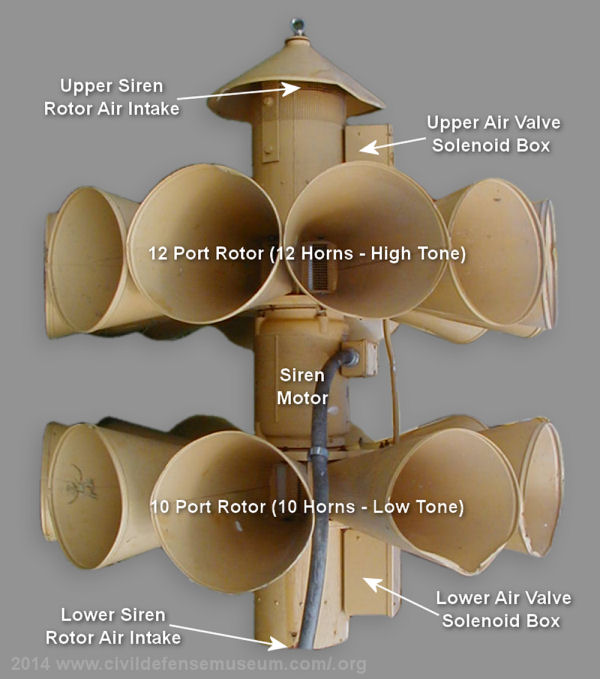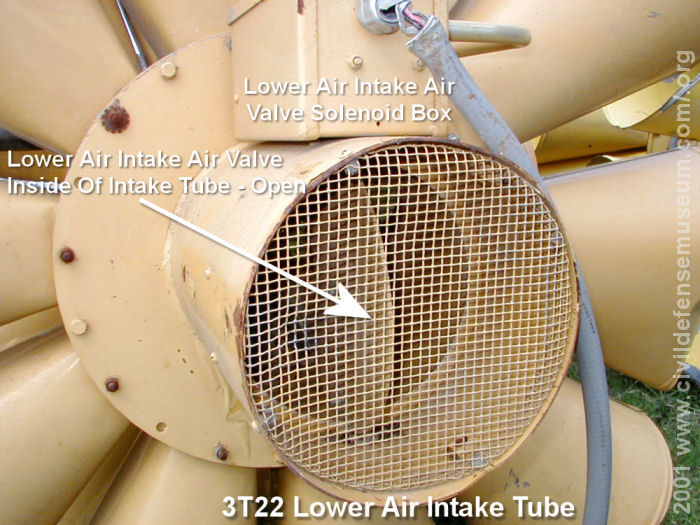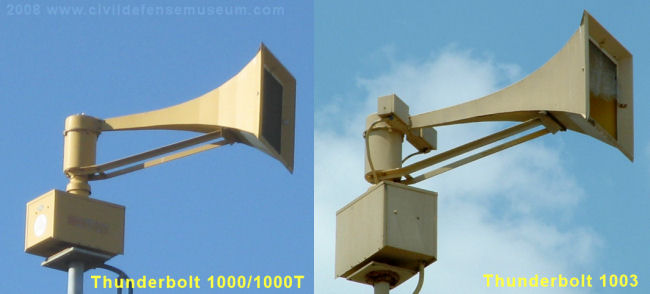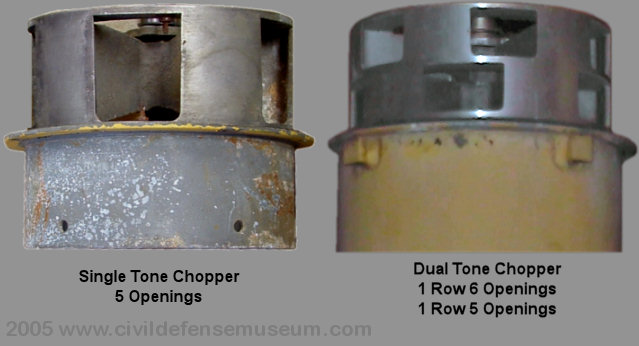
Federal 3-Signal
Fire Sirens
Sirens Main
Back to Civil Defense Museum Main
On this page I try to explain how the Federal 3T22 and Thuderbolt 1003 sirens work. These two sirens are capable of doing and extra "Fire" signal because they can switch their high and low tones off and on by valving the air going through the siren rotor. The hi-lo signal was devised to be very different from the Civil Defense Alert and Attack signal. The sirens are also capable of doing other signals as well by various switching methods of their air intake valves. Some of those are shown with my Thunderbolt 1003 in the videos at the bottom of this page.
Brett Jones Recording Of 3T22 Siren Fire Signal
Federal 3T22

The Federal 2T22 siren is a dual tone siren, which is essentially
one siren on top of another siren with the siren motor in the middle. Federal
added air valves to each air intake of the top and bottom parts of
the 2T22 siren to make it possible to alternately (or simultaneously) shut off the air to each
air intake of the siren. Shutting off the air intake virtually silences the siren because it
closes off the air flow into that part of the siren. This type of 2T22 siren is the 3T22. The purpose of
this was to produce a different Hi-Lo alternating
Fire signal for use by volunteer fire departments.
The Fire signal of a 3T22 is almost musical sounding because the 2T22 has such
a nice sound the Hi-Lo signal sounds really nice too. The Fire signal of
the 1003 Thunderbolt sounds similar but more "mean." Of course that just goes
with the territory since the Thunderbolt is such a "mean" sounding
siren. It's the blower that gives the Thunderbolt is distinctive "mean"
sound.

The above photo was taken looking into the bottom air intake tube of a Federal 3T22 siren. Just visible behind the air intake screen, inside the air intake tube, is the lower air intake air valve. At the top of the photo you can see the air lower air intake tube air valve solenoid box. This box houses the solenoid that closes the air valve. The air valve is held open by a spring and is closed when the air valve solenoid is energized. The upper air intake tube on the 3T22 has the exact same air valve arrangement as the bottom air intake tube. The 3T22 uses the same air valve solenoids that the Thunderbolt 1003 uses. (See 1003 Section Below).
Federal Thunderbolt 1003

The above photos show a comparison between the Thunderbolt 1000/1000T chopper/rotator and the Thunderbolt 1003. You can see in the photo that the 1003 has a taller rotator box and and the additional feature of a solenoid housing between the horn and the chopper housing. The housing at the base of the horn on the 1003 contains the air valves and solenoids. The tubes coming off of each side of the housing contain the wiring to the solenoids. The wiring is connected to a set of brushes and a collector rings inside the rotator box. See detail of the solenoid housing at the bottom of this page. Only the 1003 Thunderbolt has this housing at the base of the horn. For more detail about how the Thunderbolt works see this section. Thunderbolt Restoration.

Here are two photos of the different types of Thunderbolt choppers. This is what the chopper rotor looks like with the top (stator) removed. The single tone chopper on the left has five large openings and the dual-tone chopper on the right has an upper row of six (high tone) openings and a lower row of five openings (low tone). The two rows of openings on the same chopper cause the siren to have a dual-tone sound. The two air valves in the 1003 solenoid/air valve housing (see below) act to close off the different rows of ports. The air valves are held open with springs and are only closed when the solenoids are energized.

Federal couldn't stop the incoming air to the 1003 Thunderbolt siren since
the siren rotor (chopper) is located in a closed housing with the outlet
at the base of the horn and the air supply is forced through the chopper by the blower.
The 1003 Thunderbolt uses two solenoid activated
air valves to close off the air coming out of each half of the chopper. Alternately
closing each valve causes the 1003 Thunderbolt to do the Hi-Lo Fire signal. These valves
can also be switched on and off simultaneously to cause a pulse signal. See videos at bottom
of page.
The above photo shows a plan-view photo of the 1003 solenoid/air valve box showing the
low tone solenoid (left) air valve (center) and the high tone solenoid (right).
When the solenoids are at rest the air valves are open. When the solenoids
are energized they close the air valves. The springs attached to the solenoid
plunger hold the air valves open.
Click photo to see larger version.
Videos Demonstrating The Thunderbolt 1003 Solenoid Operation.
Completely Ridiculous Video I Made When I Had Two Thunderbolt 1003s. Hi-Lo.
My Thunderbolt 1003 Doing A Pulse Cycle
My Thunderbolt 1003 Doing An "Alternate Wail" Signal